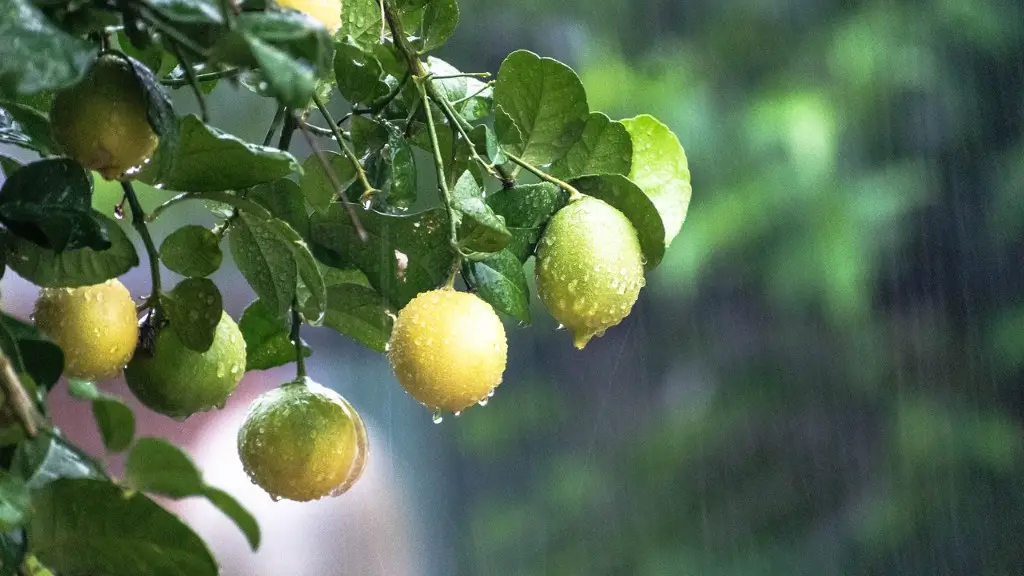Growing citrus under a lemon tree can be a great way to keep your backyard full of plants. It is important to ensure that you are choosing the right plants to grow so your lemon tree is not only healthy, but also able to get the proper nutrition that it needs. Here are some tips for what to plant under a lemon tree to ensure a booming garden.
First, it is important to make sure that you select companion plants that can handle the shade. While lemon trees do best in full sun, they will produce better if planted alongside other compatible foliage, offering your lemon tree the opportunity to get the sunlight it needs, without shading other plants too much. Shade-tolerant herbs and flowers like mint, Majorcan turmeric, rosemary and fern can be great additions beneath your lemon tree.
Next, you’ll want to choose plants that are low-maintenance and low-water. Citrus trees aren’t big on water, so when you’re growing them alongside other foliage, be sure to select varieties that won’t need too much to thrive. Succulents and cacti are great options for growing under or near a lemon tree.
Additionally, it is essential to select plants with similar pH requirements to the lemon tree. Citrus trees do best in middling acidic to slightly alkaline soil, so choose companion plants with the same needs. Cilantro, parsley, and chamomile are all compatible choices that can be planted alongside a lemon tree.
Finally, be sure to select plants that can tolerate the same weather conditions. If you live in a place with extreme conditions, like a cold winter, hot summer, or suffer from drought conditions, be sure to pick plants that are resilient enough to handle this climate. Mediterranean herbs like Greek oregano, thyme and rosemary tend to do well in a variety of climate types.
Propagating plants to grow under a lemon tree
Propagating plants to grow under a lemon tree is a great way to ensure a healthy and plentiful garden. By propagating the companion plants you select, you can ensure they take to their new environment with ease, and are already well adapted to the soil and climate in your area. Many native plants of the same family will propagate easily, though some may need a bit of extra love and attention in order to get them to thrive.
When it comes to propagating companion plants for your lemon tree, it is important to ensure you are using appropriate methods. For example, if you are trying to grow mint plants, be sure to select a mature stem without any buds and plant it in a pot with fresh potting mix. You’ll also want to ensure that the pot is well drained, as mint plants do not like their roots to get too damp.
It’s also important to make sure you are selecting the best plants for propagation. One great option for growing under a lemon tree is Mediterranean herbs like oregano, rosemary and thyme. These herbs can be propagated by stem cuttings, or even sown from seed if you’re so inclined. Be sure to select varieties that are suited to the climate and conditions of your area.
Finally, when you are propagating plants to grow beneath a lemon tree, it is important to make sure that you are giving them the proper care. Water them regularly, but be sure to not over water, as this can cause root rot and other issues. Fertilize the soil if necessary and prune the plants as needed to ensure they receive the sunlight and air circulation they need.
Growing vegetables under a lemon tree
Growing vegetables under a lemon tree is a great way to get a steady supply of fresh, nutritious produce. Knowing what vegetables will do best in the shade cast by your lemon tree can be a challenge however, so here are some tips for choosing the right vegetable varieties for your needs.
To start, opt for shade-tolerant varieties of vegetables. Peas, kale and radishes are all excellent choices, as are leafy greens like chard, lettuce and spinach. Carrots and beets can also be grown under the shade of your lemon tree as long as they are provided with some warmth and sun.
Additionally, make sure to pick vegetables that require the same amount of water and care as your lemon tree. Citrus trees don’t need a lot of water, so be sure to choose vegetables that are drought tolerant and don’t require heavy fertilization. Vegetables like potatoes, sweet potatoes, onions and garlic all make great choices, as do winter squashes like pumpkins and zucchinis.
Finally, select vegetables that have the same pH requirements as your lemon tree. Citrus trees prefer middling soil pH, and having vegetables with similar requirements will help to ensure a balanced and healthy garden. Tomatoes, peppers and cucumbers are all great options, as are pole beans and bush beans.
Harvesting and pruning your lemon tree
Harvesting and pruning your lemon tree is an essential part of ensuring it produces the best fruit possible. Knowing how and when to prune and harvest your lemon tree will help to ensure that it is healthy and able to produce an abundant harvest. Here are some tips for how to properly harvest and prune your lemon tree.
When you begin harvesting your lemon tree, it is important to keep in mind that lemons ripen gradually. As such, you will want to check for ripening fruit regularly and pick the fruits when they are ready. Be sure to use a sharp pair of pruners or shears to ensure a clean cut, as this will help the fruit last longer and maintain its quality.
Pruning is another essential step in caring for your lemon tree. Pruning should be done when the tree is young in order to promote healthy growth, as pruning helps to remove dead or diseased branches and encourages new growth. Pruning should be done in late winter or early spring, as this is when the tree is dormant and the risk of shock is lowest.
Once you are done pruning, it is a good idea to give your lemon tree a light fertilizing. Citrus trees require a steady supply of nitrogen and phosphorus in order to thrive, so make sure to select a citrus fertilizer for the best results. Be sure to follow the directions on the package for the best results.
Finally, it is important to keep an eye on the soil around your lemon tree for any signs of leaf disease or nutrient deficiencies. If you notice any of these issues, you’ll want to take steps to remediate them as soon as possible, as this can help to ensure a long and healthy life for your lemon tree.
Caring for a lemon tree
Caring for a lemon tree is important in order to get the best fruit possible. It is important that you provide your tree with the right amount of water, sunlight, and nutrients to ensure that it thrives. Here are some tips for how to properly care for your lemon tree.
First, it is important to make sure your lemon tree is getting enough water. Citrus trees should be watered deeply and thoroughly whenever the soil is dry to the touch, making sure water reaches all the way to the roots. Overwatering can be an issue with lemon trees, as can under-watering, so be sure to check the soil often and water accordingly.
Second, make sure to provide your lemon tree with proper nutrition. Citrus trees require a steady supply of nitrogen and phosphorus as well as trace minerals like sulfur, magnesium and iron to stay healthy. Feed your lemon tree organic fertilizer or use compost to ensure proper nutrition.
Third, provide your lemon tree with a bit of extra love. Citrus trees are resilient plants, but they can sometimes suffer from nutrient deficiencies and disease. Keep an eye out for any signs of ill health and take action if necessary. If your tree starts to show signs of distress, be sure to act quickly and get help as soon as possible.
Finally, make sure your lemon tree is getting enough light. While citrus trees do best in full sun, they will suffer if exposed to too much. Planting other companion plants nearby can help to provide the shade the tree needs in order to thrive.
Common diseases of a lemon tree
Knowing about the common diseases of a lemon tree can help you diagnose and treat any issues your tree may be facing. Citrus trees can be susceptible to a variety of diseases, so it is important to keep an eye out for signs that something may be wrong with your plant.
The most common disease that affects lemon trees is citrus greening. Citrus greening is caused by a bacteria and is characterized by yellowing leaves, fruit that is a bit misshapen, and a reduced growth in the tree. It is a serious condition and can spread quickly, so be sure to contact a professional if you suspect your tree may have it.
Aphids and whiteflies can also be a problem for lemon trees. These pests often cling to the underside of leaves and suck the sap from the plant, causing brown spots and distorted leaves. In extreme cases, the leaves of your lemon tree may curl or discolor. To keep aphids and whiteflies at bay, it is a good idea to keep the area around your lemon tree free of debris and extra foliage where the pests may hide.
Mealybugs can also be a problem for lemon trees. Mealybugs feed on the sap from the plant and can cause discoloration, wilting and distorted foliage. To treat mealybugs, it is a good idea to give your lemon tree a good spray of insecticidal soap every few weeks, and to prune any parts of the tree where the mealybugs are congregating.
Finally, root rot can be a serious problem for lemon trees. If your tree’s roots are suffering from root rot, the leaves may start to yellow and the tree may suffer from nutrient deficiencies. To prevent root rot it is important to ensure the tree gets enough water and is not over watered, and that the soil is aerated enough.




